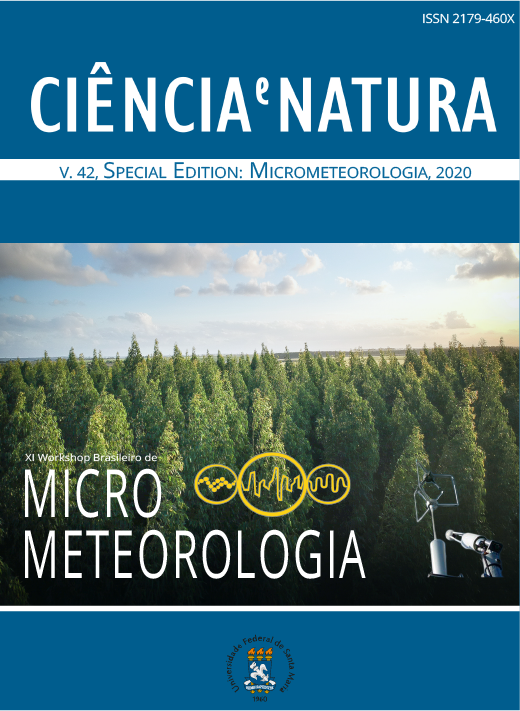Plume segment model with stochastic speeds for atmospheric dispersion in low wind conditions
DOI:
https://doi.org/10.5902/2179460X45353Keywords:
Low wind, Stochastic, Dispersion, Analytical solutionAbstract
This work presents an analytical solution for the transient three-dimensional advection-diffusion equation. This solution, obtained from a combination of the variable separation method and GILTT (Generalized Integral Laplace Transform Technique) is used to simulate the pollutant dispersion in the atmosphere. The new solution has the advantage of not requiring a numerical inversion performed in the temporal variable in works using only GILTT technique. The model was tested in low wind condition, with diffusion in transverse and longitudinal directions and stochastic speeds. Simulations were performed for the INEL experiment. The analytical character of the model makes it simple, which represents advantages in its development and implementation, as well as in the computational cost for execution.
Downloads
References
BRUSASCA, G.; TINARELLI, G.; ANFOSSI, D. Particle model simulation of diffusion in low wind speed stable conditions. Atmospheric Environment, v. 26A, p. 707–723, 1992.
BUSINGER, J.; WYNGAARD, J. C.; IZUMI, Y.; BRADLEY, E. F. Flux–profile relationships in the atmospheric surface layer. Journal of the Atmospheric Sciences, v. 28, p. 181–189, 1971.
FURTADO, I. C.; BODMANN, B. E. J.; VILHENA, M. T. On the reconstruction of concentration distributions from comparison of deterministic predictions to observational data. American Journal of Environmental Engineering, v. 6, n. 4(A), p. 6–11, 2016.
GONCALVES, G. A.; BUSKE, D.; QUADROS, R. S.; WEYMAR, G. J. A new approach to solve the time-dependent three-dimensional advection-diffusion equation applied to model air pollution dispersion in the planetary boundary layer. International Journal of Development Research, v. 8, p. 20535–20543, 2018.
LOECK, J. F. Efeitos estocásticos em modelos determinísticos para dispersão de poluentes na camada limite atmosférica. 2014. 81 f. Dissertação (Mestrado em Engenharia) — Universidade Federal do Rio Grande do Sul, Porto Alegre, 2014.
OETTL, D.; ALMBAUER, R. A.; STURM, P. J. A new method to estimate diffusion in stable, low-wind conditions. American Meteorological Society, v. 40, p. 259–268, 2001.
PASQUILL, F.; SMITH, F. B. Atmospheric Diffusion. 2. ed. New York: Halsted Press, 1983.
SAGENDORF, J. F.; DICKSON, C. R. Diffusion under low wind-speed, inversion conditions. [S.l.], 1974.
SHARAN, M.; SINGH, M.; YADAV, A. K. A mathematical model for the dispersion in low winds with eddy diffusivities as linear functions of downwind distance. Atmospheric Environment, v. 30, p. 1137–1145, 1996.
SHARAN, M.; YADAV, A. K. Simulation of experiments under light wind, stable conditions by a variable k-theory model. Atmospheric Environment, v. 32, p. 3481–3492, 1998.
SHARAN, M.; YADAV, A. K.; MODANI, M. Simulation of short-range diffusion experiment in low-wind convective conditions. Atmospheric Environment, v. 36, p. 1901–1906, 2002.
SILVEIRA, V. C. d. Simulação tridimensional da dispersão de poluentes em um modelo Euleriano considerando o efeito do meandro do vento. 2017. 143 f. Tese (Doutorado em Meterologia) — Universidade Federal de Santa Maria, Santa Maria, 2017.
Downloads
Published
How to Cite
Issue
Section
License
To access the DECLARATION AND TRANSFER OF COPYRIGHT AUTHOR’S DECLARATION AND COPYRIGHT LICENSE click here.
Ethical Guidelines for Journal Publication
The Ciência e Natura journal is committed to ensuring ethics in publication and quality of articles.
Conformance to standards of ethical behavior is therefore expected of all parties involved: Authors, Editors, Reviewers, and the Publisher.
In particular,
Authors: Authors should present an objective discussion of the significance of research work as well as sufficient detail and references to permit others to replicate the experiments. Fraudulent or knowingly inaccurate statements constitute unethical behavior and are unacceptable. Review Articles should also be objective, comprehensive, and accurate accounts of the state of the art. The Authors should ensure that their work is entirely original works, and if the work and/or words of others have been used, this has been appropriately acknowledged. Plagiarism in all its forms constitutes unethical publishing behavior and is unacceptable. Submitting the same manuscript to more than one journal concurrently constitutes unethical publishing behavior and is unacceptable. Authors should not submit articles describing essentially the same research to more than one journal. The corresponding Author should ensure that there is a full consensus of all Co-authors in approving the final version of the paper and its submission for publication.
Editors: Editors should evaluate manuscripts exclusively on the basis of their academic merit. An Editor must not use unpublished information in the editor's own research without the express written consent of the Author. Editors should take reasonable responsive measures when ethical complaints have been presented concerning a submitted manuscript or published paper.
Reviewers: Any manuscripts received for review must be treated as confidential documents. Privileged information or ideas obtained through peer review must be kept confidential and not used for personal advantage. Reviewers should be conducted objectively, and observations should be formulated clearly with supporting arguments, so that Authors can use them for improving the paper. Any selected Reviewer who feels unqualified to review the research reported in a manuscript or knows that its prompt review will be impossible should notify the Editor and excuse himself from the review process. Reviewers should not consider manuscripts in which they have conflicts of interest resulting from competitive, collaborative, or other relationships or connections with any of the authors, companies, or institutions connected to the papers.






